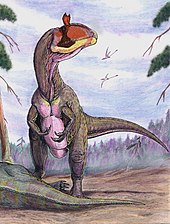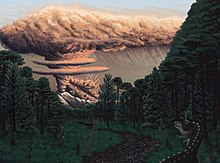
Dilophosaurus is a genus of theropod dinosaurs that lived in what is now North America during the Early Jurassic, about 186 million years ago. Three skeletons were discovered in northern Arizona in 1940, and the two best preserved were collected in 1942. The most complete specimen became the holotype of a new species in the genus Megalosaurus, named M. wetherilli by Samuel P. Welles in 1954. Welles found a larger skeleton belonging to the same species in 1964. Realizing it bore crests on its skull, he assigned the species to the new genus Dilophosaurus in 1970, as Dilophosaurus wetherilli. The genus name means "two-crested lizard", and the species name honors John Wetherill, a Navajo councilor. Further specimens have since been found, including an infant. Fossil footprints have also been attributed to the animal, including resting traces. Another species, Dilophosaurus sinensis from China, was named in 1993, but was later found to belong to the genus Sinosaurus.

Tetanurae is a clade that includes most theropod dinosaurs, including megalosauroids, allosauroids, tyrannosauroids, ornithomimosaurs, compsognathids and maniraptorans. Tetanurans are defined as all theropods more closely related to modern birds than to Ceratosaurus and contain the majority of predatory dinosaur diversity. Tetanurae likely diverged from its sister group, Ceratosauria, during the late Triassic. Tetanurae first appeared in the fossil record by the Early Jurassic about 190 mya and by the Middle Jurassic had become globally distributed.
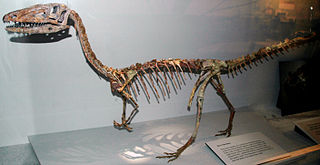
Coelophysoidea were common dinosaurs of the Late Triassic and Early Jurassic periods. They were widespread geographically, probably living on all continents. Coelophysoids were all slender, carnivorous forms with a superficial similarity to the coelurosaurs, with which they were formerly classified, and some species had delicate cranial crests. Sizes range from about 1 to 6 m in length. It is unknown what kind of external covering coelophysoids had, and various artists have portrayed them as either scaly or feathered. Some species may have lived in packs, as inferred from sites where numerous individuals have been found together.
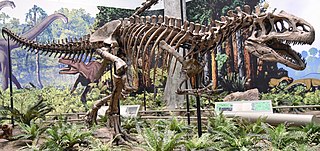
Allosauridae is a family of medium to large bipedal, carnivorous allosauroid theropod dinosaurs from the Late Jurassic. Allosauridae is a fairly old taxonomic group, having been first named by the American paleontologist Othniel Charles Marsh in 1878. Allosaurids are characterized by an astragalus with a restriction of the ascending process to the lateral part of the bone, a larger medial than lateral condyle, and a horizontal groove across the face of the condyles.

Monolophosaurus is an extinct genus of tetanuran theropod dinosaur from the Middle Jurassic Shishugou Formation in what is now Xinjiang, China. It was named for the single crest on top of its skull. Monolophosaurus was a mid-sized theropod at about 5–5.5 metres (16–18 ft) long and weighed 475 kilograms (1,047 lb).

Piatnitzkysaurus is a genus of megalosauroid theropod dinosaur that lived approximately 179 to 177 million years ago during the lower part of the Jurassic Period in what is now Argentina. Piatnitzkysaurus was a moderately large, lightly built, bipedal, ground-dwelling carnivore that could grow up to 6.6 m (21.7 ft) long.
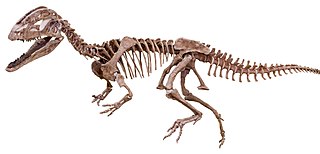
Sinosaurus is an extinct genus of theropod dinosaur which lived during the Early Jurassic Period. It was a bipedal carnivore approximately 5.5 metres (18 ft) in length and 300 kilograms (660 lb) in body mass. Fossils of the animal were found at the Lufeng Formation, in the Yunnan Province of China.

Zupaysaurus is an extinct genus of early theropod dinosaur living during the Norian stage of the Late Triassic in what is now Argentina. Fossils of the dinosaur were found in the Los Colorados Formation of the Ischigualasto-Villa Unión Basin in northwestern Argentina. Although a full skeleton has not yet been discovered, Zupaysaurus can be considered a bipedal predator, up to 4 metres (13 ft) long. It may have had two parallel crests running the length of its snout.

Allosauroidea is a superfamily or clade of theropod dinosaurs which contains four families — the Metriacanthosauridae, Allosauridae, Carcharodontosauridae, and Neovenatoridae. Allosauroids, alongside the family Megalosauroidea, were among the apex predators that were active during the Middle Jurassic to Late Cretaceous periods. The most famous and best understood allosauroid is the North American genus Allosaurus.

Dracovenator is a genus of neotheropod dinosaur that lived approximately 201 to 199 million years ago during the early part of the Jurassic Period in what is now South Africa. Dracovenator was a medium-sized, moderately-built, ground-dwelling, bipedal carnivore, that could grow up to an estimated 5.5–6.5 metres (18–21 ft) in length and 250 kilograms (550 lb) in body mass. Its type specimen was based on only a partial skull that was recovered.

The Hanson Formation is a geologic formation on Mount Kirkpatrick and north Victoria Land, Antarctica. It is one of the two major dinosaur-bearing rock groups found on Antarctica to date; the other is the Snow Hill Island Formation and related formations from the Late Cretaceous of the Antarctic Peninsula. The formation has yielded some Mesozoic specimens, but most of it is as yet unexcavated. Part of the Victoria Group of the Transantarctic Mountains, it lies below the Prebble Formation and above the Falla Formation. The formation includes material from volcanic activity linked to the Karoo-Ferar eruptions of the Lower Jurassic. The climate of the zone was similar to that of modern southern Chile, humid, with a temperature interval of 17–18 degrees. The Hanson Formation is correlated with the Section Peak Formation of the Eisenhower Range and Deep Freeze Range, as well as volcanic deposits on the Convoy Range and Ricker Hills of southern Victoria Land. Recent work has successfully correlated the Upper Section Peak Formation, as well unnamed deposits in Convoy Range and Ricker Hills with the Lower Hanson, all likely of Sinemurian age and connected by layers of silicic ash, while the upper section has been found to be Pliensbachian, and correlated with a greater volcanic pulse, marked by massive ash inputs.

Glacialisaurus is a genus of sauropodomorph dinosaur. It lived during the Pliensbachian stage of the Early Jurassic period around 186 to 182 million years ago in what is now the central region of the Transantarctic Mountains of Antarctica. It is known from two specimens; the holotype, a partial tarsus (ankle) and metatarsus, and a partial left femur. The fossils were collected by a team led by paleontologist William R. Hammer during a 1990–91 field expedition to the Hanson Formation of Antarctica. They were described in 2007, and made the basis of the new genus and species Glacialisaurus hammeri. The genus name translates as “icy” or "frozen lizard”, and the species name honors Hammer.
William Roy Hammer is an American paleontologist who is credited with the discovery of the first carnivorous dinosaur unearthed in Antarctica, Cryolophosaurus, in 1991. He was professor of geology and curator of the Frxyell Geology Museum at Augustana College in Rock Island, IL from 1981 to 2017.

Neotheropoda is a clade that includes coelophysoids and more advanced theropod dinosaurs, and is the only group of theropods that survived the Triassic–Jurassic extinction event. All neotheropods became extinct by the end of the Early Jurassic except for Averostra.
Kayentavenator is a genus of small carnivorous tetanuran dinosaur that lived during the Early Jurassic Period; fossils were recovered from the Kayenta Formation of northeastern Arizona and were described in 2010.

Sarahsaurus is a genus of basal sauropodomorph dinosaur which lived during the Early Jurassic period in what is now northeastern Arizona, United States.

Averostra, or "bird snouts", is a clade that includes most theropod dinosaurs, namely Ceratosauria and Tetanurae, and represent the only group of post-Early Jurassic theropods. Both survived into the Cretaceous period. When the Cretaceous–Paleogene extinction event occurred, ceratosaurians, megaraptorans an incertae sedis group within Tetanurae, and two groups of tetanurans within the clade Coelurosauria, the Tyrannosauroidea and Maniraptoriformes, were still extant. Only one subgroup of Maniraptoriformes, Aves, survived the extinction event and persisted to the present day.

Megapnosaurus is an extinct genus of coelophysid theropod dinosaur that lived approximately 188 million years ago during the early part of the Jurassic Period in what is now Africa. The species was a small to medium-sized, lightly built, ground-dwelling, bipedal carnivore, that could grow up to 2.2 m (7.2 ft) long and weigh up to 13 kg (29 lb). It was originally given the genus name Syntarsus, but that name was later determined to be preoccupied by a beetle. The species was subsequently given a new genus name, Megapnosaurus, by Ivie, Ślipiński & Węgrzynowicz in 2001. Some studies have classified it as a species within the genus Coelophysis, but this interpretation has been challenged by more subsequent studies and the genus Megapnosaurus is now considered valid.
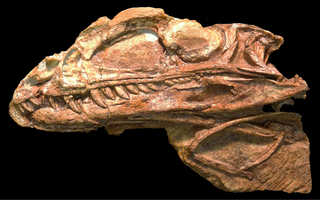
Coelophysis? kayentakatae is an extinct species of neotheropod dinosaur that lived approximately 200–196 million years ago during the early part of the Jurassic Period in what is now the southwestern United States. It was originally named Syntarsus kayentakatae, but the genus Syntarsus was found to be preoccupied by a Colydiine beetle, so it was moved to the genus Megapnosaurus, and then to Coelophysis. A recent reassessment suggests that this species may require a new genus name.
Shuangbaisaurus is genus of theropod dinosaur, possibly a junior synonym of Sinosaurus. It lived in the Early Jurassic of Yunnan Province, China, and is represented by a single species, S. anlongbaoensis, known from a partial skull. Like the theropods Dilophosaurus and Sinosaurus,Shuangbaisaurus bore a pair of thin, midline crests on its skull. Unusually, these crests extended backwards over the level of the eyes, which, along with the unusual orientation of the jugal bone, led the describers to name it as a new genus. However, Shuangbaisaurus also possesses a groove between its premaxilla and maxilla, a characteristic which has been used to characterize Sinosaurus as a genus. Among the two morphotypes present within the genus Sinosaurus, Shuangbaisaurus more closely resembles the morphotype that is variably treated as a distinct species, S. sinensis, in its relatively tall skull.






